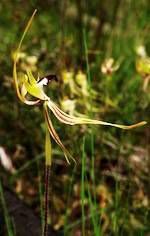This is the time of the year when we should be able to admire the late flowering sun orchids, Pale-flowered Sun Orchid Thelymitra pallidiflora and the Blotched Sun Orchid Thelymitra benthamiana.

Pale-flowered Sun Orchid

Blotched Sun Orchid
However, if you have managed to see either of these species in flower, you have done well. The cool, windy conditions were just not favourable for our sun orchids this season, and the majority of them just self-pollinated, without even bothering to open.
On the other hand, the Mantis Orchid Caladenia tentaculata has continued to flower over the last few months, and many people have told me of the beautiful specimens they have seen throughout the district.

The Moggs Creek picnic ground has had a wonderful display of this attractive, green-comb spider orchid, with its large, green and maroon flowers, on flower stems up to 50 cm high.
Another genus that flowered well this season was the Leek Orchids. However, their flowers were short-lived. An orchid field trip in early November saw ANOS members down on their hands and knees endeavouring to determine the slight differences between our three ‘species’ of Prasophyllum odoratum orchids. While we felt confident with our deliberations, it can be a frustrating exercise, and it is better just to enjoy the experience of viewing the flower spikes with their display of beautiful flowers.

Scented Leek Orchid
An orchid that is very easy to recognise is the Tiger Orchid Diuris sulphurea with its bright sulphur-yellow flowers with dark brown markings. Although it is not a common orchid in our area, some very fine specimens have been seen over the last few weeks.

Tiger Orchid
Flying Duck Orchids Caleana major can now be seen in many places throughout the district. These glossy, dark-coloured flowers resemble ducks in flight.

Flying Duck Orchid
The labellum is the head and neck of the duck, while the lateral sepals form the wings. The petals and the dorsal sepal are held close to the column, with these three parts forming the body of the duck. The labellum snaps down into the winged column at the slightest touch, to trap insect pollinators. To see a large colony of these orchids in flower is a sheer delight.
Keep your eyes open for the summer flowering orchids – Hyacinth Orchids, Large Tongue Orchids, Small Duck Orchids, Horned Orchids, Cinnamon Bells, and hopefully, the elusive Elbow Orchids.
Photos and descriptions of all the orchids that grow in the Anglesea district are documented in Orchids of the Anglesea District available from Angair.